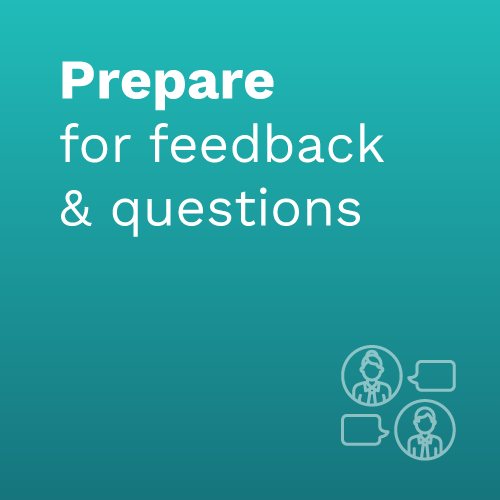DIME PROJECT

Implementing AI in Healthcare
Plan the foundation
Establish the foundation for safe, strategic, and effective AI implementation.
During planning, you will…
-
 Form an AI implementation task force
Form an AI implementation task force -
 Convene your governance committee
Convene your governance committee -
 Validate data and workflow alignment
Validate data and workflow alignment -
 Manage risk and set compliance
Manage risk and set compliance -
 Define KPIs and measures of success
Define KPIs and measures of success -
 Develop a communication plan
Develop a communication plan
Form an AI implementation taskforce
Who should core personnel include?
Core personnel to include:
- Patient/family representative (see Spotlight below for real-world example on integrating patient AI use into your strategy)
- Clinical lead (e.g. department champion)
- IT systems/integration lead
- Data science/analytics lead
- Governance/compliance lead
- Project management and operational owner
- Frontline end-user (nurse, physician, coordinator)
RACI Table
Use a RACI table, like the example below, to define internal team roles and prevent accountability gaps.
Key: Responsible, Accountable, Consulted, and Informed
| Task | Clinical Champion | CMIO | IT Lead | Ops Director |
|---|---|---|---|---|
|
Workflow validation |
A |
C |
C |
R |
|
EHR integration |
C |
R |
A |
C |
|
Frontline communication |
A |
R |
C |
C |
|
Failover protocol design |
C |
R |
A |
C |
Integrating patient AI use into your strategy
Patient adoption of AI is accelerating, making it a strategic imperative for health systems to adapt policies, workflows, and support mechanisms. In a Deep Dive interview, our colleague Grace Cordovano, PhD, BCPA outlines what health systems can, including
- Develop governance and clinical protocols that safely guide patient AI use.
- Invest in patient co-design to ensure AI tools align with real-world needs and drive engagement.
“When we talk about patients using AI, it’s not just about using an LLM. Patients and their carepartners are creating new workflows that we’ve never had access to, and they’re here at our fingertips… This is patient engagement, by the way—so this is the holy grail that everyone tries to unlock. It’s here, probably at scale in many cases, and the health systems and the doctors …don’t have a workflow or culture adjustment to accept it.”
– Grace Cordovano, PhD, BCPA, DiMe Patient in Residence
Read more about the conversation here.
Convene your governance committee
Beyond the implementation taskforce, identify or form a formal governance body (e.g., an AI subcommittee of the P&T or Quality and Safety Committee). This committee is responsible for:
- Providing high-level oversight
- Reviewing and approving validation plans
- Making the final go/no-go decision for clinical use
- Overseeing ongoing safety and performance monitoring reported from the field.
Some of the roles and responsibilities of a committee include:
-
Chief Medical Information Officer / Clinical Champion
Define safe thresholds, review clinical overrides, track adoption trends, surface clinician feedback.
-
Chief Information Officer / IT Ops Lead
Ensure infrastructure, uptime, integration monitoring, and automated alerts are in place.
-
Chief Data Officer / Data Science Lead
Build monitoring pipelines, perform drift detection, bias audits, and manage recalibration schedules.
-
Quality & Patient Safety Lead
Investigate safety signals, coordinate RCA for adverse AI-driven events, communicate findings.
-
Frontline Clinicians
Report usability issues, unintended consequences, and safety risks; close the loop on workflow alignment.
SPOTLIGHT
What makes a strong governance process?
Susannah Rose, PhD, of Vanderbilt University Medical Center (VUMC), details a robust AI governance process, highlighting the importance of high-level, cross-functional oversight, pre-approval evaluation, and continuous monitoring for safety and performance of deployed AI tools.
“I think that there’s an importance for healthcare systems, and even more widely the healthcare environment to work more collaboratively together”
– Susannah Rose, PhD Vanderbilt University Medical Center
Validate performance, align workflows and set KPIs
AI tools can deliver excellent outcomes for one patient group but not for others;
Validating algorithms against your specific population is critical. Even FDA-cleared tools often skip population-specific validation. Only 1.7% of AI/ML-enabled pediatric devices disclosed using pediatric datasets in their validation—even when labeled for pediatric use. This regulatory gap can expose children to the risks of off-label use or delays in care. Marla Sammer, MD, MHA, FAAP, of Texas Children’s Hospital shares case studies illustrating how a tool used to detect strokes in adults could lead to potential harm in children.
Establish data harmonization and robust pipelines
The quality of an AI tool’s output is entirely dependent on the quality of its input data. Before validation can even begin, a significant technical lift is often required to ensure data is not only available but also clean, consistent, and correctly formatted. This is a foundational IT and data science responsibility.
- Map and harmonize data sources: Identify all required data inputs and create a clear map from source systems (e.g., EHRs, PACS, lab systems) to the model’s required format. This often involves harmonizing data from multiple, disparate systems with different standards.
- Build and test data pipelines: Develop automated, production-grade data pipelines to feed the model. These pipelines must be monitored for timeliness, completeness, and accuracy, as any disruption can disable the AI tool or lead to erroneous outputs.
- Address data gaps and biases: Proactively identify potential data gaps or historical biases that could undermine the model’s performance or equity. Develop strategies to mitigate these issues before live deployment.
Choose your validation approach
You’re ready to pilot the tool in a controlled environment. Depending on the use case you might consider different validation methods. Variables like, risk, workflow complexity, and data harmonization will influence your decision. Some questions you might be asking yourself during validation:
Data:
- Is the required data accessible?
- Is the required data accurate?
- Is the required data timely?
- Is the required data representative?
- Are there data gaps that will undermine performance?
- Are there data biases that will undermine performance?
- Are there interoperability issues that will undermine performance?
Workflows
- When is the AI triggered?
- What clinical action does the AI inform?
- How is the AI recommendation documented?
- How is the AI recommendation acted upon?
- Where could errors occur in the workflow?
- Where could friction occur in the workflow?
Common validation methods
|
Method |
Description |
Use case |
|
Retrospective validation |
Test tool on historical data to compare predictions with known outcomes. |
Early-stage assessment or comparing vendors. |
|
Operational simulation |
Sandbox testing with simulated workflows and clinician input. |
Workflow-intensive tools (e.g., ambient documentation). |
|
Silent/shadow mode |
Run model live but invisible to end-users. Compare outputs to the current standard of care. |
Real-time predictive models not yet approved for live use. |
|
Prospective pilot |
Deploy in a limited clinical setting with structured feedback. |
High-impact tools requiring frontline adoption. |
Performance metrics
Your test needs measurable outcomes. The metrics that matter most for AI in healthcare come down to accuracy, efficiency, and safety. These determine whether an AI system can actually support clinicians, improve outcomes, and lower costs.
-
Accuracy: How often the AI gets it right — typically broken down into sensitivity (true positive rate) and specificity (true negative rate). For example, some FDA-cleared systems for diabetic retinopathy screening report sensitivity up to 87% and specificity at 90%.
-
AUC-ROC: A standard way to see how well the AI separates signal from noise (disease vs. no disease). Especially important for diagnostic tools.
-
Task Completion Rate: The percent of jobs the AI actually finishes without human rescue. A practical measure of operational reliability.
-
Factual Accuracy / Hallucination Rate: For generative models, the key question is: how often does the system make things up? Tracking hallucination is essential for patient safety and trust.
Efficiency Metrics: How much time, compute, and cost it takes to run the model. These matter because speed and throughput often trade off against quality.
What this means for care delivery
- Speed: AI can drastically cut wait times and improve workflow efficiencies.
- Consistency: Unlike humans, AI doesn’t fatigue. It can smooth out variability and reduce oversight errors.
- Data and feedback: Metrics should also track data completeness, reliability, and user satisfaction. Poor data or bad UX can sink performance regardless of model accuracy.
Manage risk and set compliance
-
Clinical Risks
- Diagnostic errors: False positives/negatives can lead to delayed care or unnecessary interventions. Even small error rates scale quickly in high-volume settings.
- Workflow Mismatch: Poor integration can create extra clicks or disrupt clinical flow, which reduces adoption and may increase error.
- Overreliance: Clinicians may defer too heavily to AI recommendations, reducing vigilance and critical thinking.
-
Operational Risks
- System reliability: Downtime, latency, or model drift can compromise patient care. Monitoring and fallback plans are essential.
- Data quality gaps: Incomplete, biased, or poor-quality data feeding the system leads to flawed outputs.
- Cost overruns: Underestimating infrastructure, integration, and retraining costs can make projects financially unsustainable.
-
Ethical & Equity Risks
- Bias and inequity: Models trained on non-representative data can perform worse for certain populations, reinforcing health disparities.
- Transparency and explainability: If outputs aren’t interpretable, clinicians may mistrust the system — or worse, follow it blindly.
- Privacy: Sensitive health data must be protected across hosting environments (cloud, on-prem, edge).
-
Regulatory & Legal Risks
- Compliance: Failure to meet FDA, HIPAA, GDPR, or local health authority standards can stall or shut down deployments.
- Liability: Ambiguity over who’s responsible when AI makes an error (the vendor, the health system, or the clinician) creates legal exposure.
- Rapidly evolving rules: Regulatory frameworks for AI in healthcare are still emerging, making long-term planning uncertain.
Risks will show up as safety events, workflow failures, and inequities if left unmanaged. The systems that succeed are those that treat risk management as part of deployment, not an afterthought. Build structured guardrails, like:
- Independent validation before clinical use.
- Continuous monitoring for drift, safety, and bias.
- Governance bodies with clinical, IT, and legal input.
- Clear escalation and accountability pathways when things go wrong.
- Accessible and clear policies.
Define KPIs and measures of success
Be clear on what success looks like up front. What are you trying to prove in early deployment? What needs to be true for scale?
- Define clinical, operational, and user experience metrics
- Set measurement cadence, reporting structure, and owners
- Employ a balanced approach to create a holistic view of AI’s impact.
![]() PRO TIP | Align use cases with strategic priorities
PRO TIP | Align use cases with strategic priorities
A good use case solves a real, measurable problem and delivers true value to your organization. By ensuring the AI tool is solving a problem that matters you should synchronize use cases to existing clinical, operational, or financial priorities, like reducing readmissions, improving documentation quality, or optimizing throughput.
Use your taskforce to confirm alignment in the problem and the proposed AI solution and identify any overlapping initiatives, funding needs, or infrastructure constraints that may affect implementation.
Some metrics to consider include:
-
Clinical
- % reduction in diagnostic error
- Improved patient outcomes (e.g., reduced mortality, readmission rates)
- Accuracy of predictions/diagnoses
- Sensitivity and specificity of AI models
- Time to diagnosis
- Reduction in adverse events
-
Operational
- Time saved per workflow step
- Efficiency gains in administrative tasks
- Throughput of patient encounters
- Reduction in staff burnout
- Improved resource allocation
-
Financial
- Cost savings from avoided procedures
- Reduction in hospital stay length
- Optimized supply chain costs
- Increased revenue from new services
- Return on investment (ROI)
-
Population representation
- Performance parity across demographics
- Reduction in healthcare disparities
- Access to care for underserved populations
- Fairness metrics (e.g., algorithmic bias detection)
-
Patient experience
- Patient satisfaction scores
- Improved communication with healthcare providers
- Enhanced patient engagement
- Reduced wait times
- Personalized treatment plans
-
Safety & trust
- Number of AI-related incidents or errors
- Transparency and interpretability of AI models
- Adherence to regulatory guidelines
- Patient and clinician trust in AI systems
Develop a communication plan
A clear and consistent communication plan is essential for successful deployment. Ensure all stakeholders are informed and engaged throughout the process.

Determine who needs to be informed (e.g., leadership, end-users, IT, legal, patients).

Tailor messages to different audiences and select appropriate communication channels (e.g., email, internal newsletters, town halls, training sessions, dedicated portals).

Plan regular updates and milestones.

Set up mechanisms for stakeholders to provide feedback and ask questions, and designate clear points of contact for responses.

Explain the “why” behind the deployment, its benefits, and how it aligns with organizational goals.
